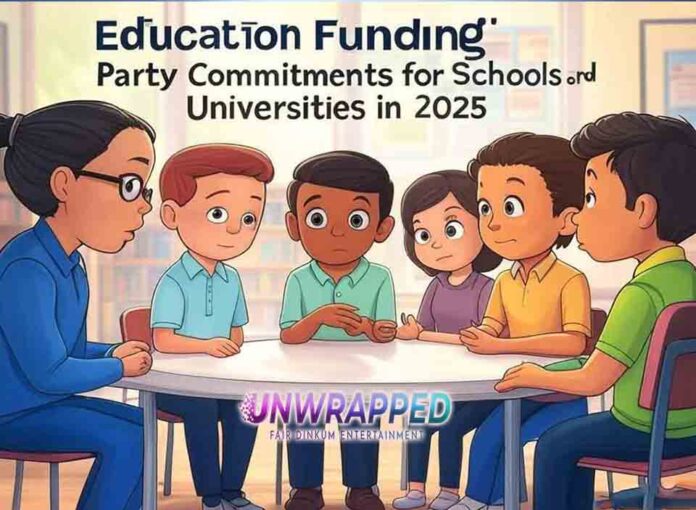As the 2025 federal election approaches, education funding is emerging as one of the most critical issues shaping Australia’s future. From addressing inequalities in school resources to ensuring that universities can thrive in an increasingly competitive global landscape, political parties are laying out their visions for the nation’s education system. But what are their commitments, and how will they impact schools, universities, and students?
Introduction: Why Education Funding Matters in 2025
Education is the foundation of a strong, innovative, and equitable society. It drives economic growth, reduces inequality, and prepares the next generation to tackle future challenges. In 2025, education funding is under the spotlight, as schools and universities face mounting pressures from rising costs, digital transformation, and demands for better outcomes.
This article explores the education funding promises made by Australia’s major political parties, the challenges facing schools and universities, and the opportunities for transformative change.
The State of Education in Australia: A Snapshot
1. Schools
- Funding Disparities: Government schools educate 65% of Australian students but often operate with fewer resources compared to private and independent schools.
- Student Outcomes: Australia’s performance in international assessments like PISA has declined in recent years, raising concerns about the quality of education.
- Digital Divide: Many regional and low-income schools lack access to modern technology, exacerbating educational inequalities.
2. Universities
- Global Competition: Australian universities face stiff competition from global institutions while recovering from the financial impacts of COVID-19.
- Student Debt: Higher education costs continue to rise, leading to growing concerns about student debt.
- Research Funding: Declining investment in university research threatens Australia’s position as a global leader in innovation.
External Resource: Learn more about Australia’s education statistics from the Australian Bureau of Statistics (ABS).
Party Commitments for Education in 2025
Labor Party: Investing in Equity and Access
Labor’s education policies focus on reducing disparities and expanding access. Key proposals include:
- Public School Funding: Committing $4 billion over four years to ensure all public schools reach 100% of their fair funding target.
- Free TAFE Courses: Expanding the Free TAFE initiative to cover high-demand industries like healthcare, technology, and renewable energy.
- University Funding: Increasing funding for research grants and reducing reliance on international student fees.
Labor argues that education is a public good that requires robust investment to build a fairer society.
Coalition: Supporting Choice and Innovation
The Coalition emphasizes parental choice and private sector involvement in education. Their key initiatives include:
- Independent School Funding: Maintaining strong funding levels for private and independent schools.
- STEM Initiatives: Allocating $1.5 billion for STEM programs in schools to boost Australia’s tech and innovation sectors.
- Vocational Training: Partnering with industry to expand apprenticeship programs and improve pathways from education to employment.
The Coalition frames its policies as supporting innovation, economic growth, and individual choice.
The Greens: Prioritizing Universal Access and Sustainability
The Greens advocate for free, universally accessible education at all levels. Their platform includes:
- Free Public Education: Fully funding public schools and making university education free for all Australians.
- Teacher Support: Increasing teacher salaries and funding for professional development.
- Sustainable Schools: Investing in solar panels, energy-efficient buildings, and sustainability programs in schools.
The Greens argue that education is a human right and should be accessible to everyone, regardless of socioeconomic status.
Key Issues in Education Funding for 2025
1. Addressing Inequality
Education funding disparities between public and private schools remain a contentious issue. Proposed solutions include:
- Redirecting more funding to under-resourced public schools.
- Providing targeted grants for schools in low-income and regional areas.
- Supporting programs that address the unique needs of Indigenous students and communities.
2. Affordable Higher Education
With rising tuition costs, making higher education more affordable is a priority for many voters. Policies focus on:
- Reducing HECS-HELP debt burdens.
- Offering more scholarships for low-income and first-generation university students.
- Expanding government contributions to university funding.
3. Digital Transformation
Digital tools and infrastructure are critical for modern education. Areas of investment include:
- High-speed internet for all schools, including regional and remote areas.
- Training programs for teachers to integrate technology into classrooms.
- Grants for schools to upgrade digital learning tools.
Challenges and Opportunities in Education Funding
Challenges:
- Balancing Competing Needs: Ensuring equitable funding for public schools while supporting private and independent institutions.
- Post-Pandemic Recovery: Addressing learning gaps caused by COVID-19 disruptions.
- Teacher Shortages: Recruiting and retaining qualified teachers in a competitive job market.
Opportunities:
- Investing in STEM Education: Preparing students for high-growth industries like technology and renewable energy.
- Global Leadership: Enhancing research funding to solidify Australia’s position as a global education hub.
- Lifelong Learning: Expanding opportunities for adult education and reskilling initiatives.
Lessons from Global Education Models
Australia can learn from other countries excelling in education:
- Finland: Known for its equitable and high-quality public education system.
- Germany: Offers free university education while emphasizing vocational training.
- Singapore: Combines rigorous academic standards with strong teacher support and digital innovation.
These models demonstrate the value of sustained investment, equity, and adaptability in education policy.
What the 2025 Election Means for Australia’s Education System
The 2025 election is a critical moment for shaping the future of Australia’s schools and universities. Key questions for voters include:
- Are party proposals sufficient to address funding disparities and improve outcomes?
- How will policies ensure that education is accessible and affordable for all Australians?
- Do initiatives support the skills and industries of the future?
By scrutinizing party platforms, voters can advocate for policies that align with their vision for Australia’s education system.
Conclusion: Investing in Australia’s Future
Education is not just an expense—it’s an investment in Australia’s future. Whether it’s addressing funding inequalities, supporting research and innovation, or ensuring affordable access, the policies chosen in 2025 will have a lasting impact on the nation’s economic and social fabric.
As voters, we must prioritize education funding and demand bold, forward-thinking solutions from political leaders. Together, we can build an education system that empowers every Australian to thrive.
Call to Action
What are your thoughts on the education funding commitments for 2025? Do they address the key challenges facing schools and universities? Share your opinions in the comments below or join the discussion on social media. Don’t forget to subscribe for more insights into Australia’s political and education landscape!
See Also: The Debate Over Private vs. Public Healthcare in the 2025 Election










